 Why You Can Trust CNET
Why You Can Trust CNET
Years of Experience
Hands-on Product Reviewers
Sq. Feet of Lab Space
If you’re looking to get the movie theater experience at home, you’re probably better off with a projector rather than a massive 85-inch TV. Home theater projectors have gotten a lot more affordable in recent years, and they allow you to enjoy all your shows, movies and games on a stunning 100-inch-plus screen from the comfort of your own living room. You can even pair a projector with a soundbar for immersive, room-filling audio.
You can get a massive screen for a fraction of the cost of a big TV, starting at around $200. And many models are portable, making them perfect for a backyard movie night under the stars. Whether you’re looking to buy a 4K projector, want something that’ll make HD sources look great or need something you can use on the go, this list gives you the best home theater projectors we’ve tested.
What is the best overall projector?
If you’re looking for impressive picture quality, good brightness in ambient light, vivid colors and a quality contrast ratio, then the Epson Home Cinema 5050UB is the best overall home theater projector.
If you want something less expensive, the best projector for the money is the BenQ HT2050A. It’s worth noting that it’s being discontinued soon, but its replacement, the HT2060, is excellent and still one of our overall best projector picks.
The best projectors of 2023
Best overall home theater projector
Epson Home Cinema 5050UB
The Epson Home Cinema 5050UB is the best all-around home projector we’ve reviewed. Take an excellent contrast ratio, paired with impressive brightness and accurate color, all with better detail than what’s possible with a 1080p native resolution projector, and you’ve got all the pieces for a fantastic image. This home entertainment projector isn’t cheap, but it offers a significant step up in image quality over other projectors on this list (aside from the Sony, which costs a lot more). It comes with HDMI 2.0, which lets you do 4K60p. Extensive lens shift and a motorized zoom are the icing on the cake.
The Epson Home Cinema 5050UB is the best all-around home projector we’ve reviewed. Take an excellent contrast ratio, paired with impressive brightness and accurate color, all with better detail than what’s possible with a 1080p native resolution projector, and you’ve got all the pieces for a fantastic image. This home entertainment projector isn’t cheap, but it offers a significant step up in image quality over other projectors on this list (aside from the Sony, which costs a lot more). It comes with HDMI 2.0, which lets you do 4K60p. Extensive lens shift and a motorized zoom are the icing on the cake.

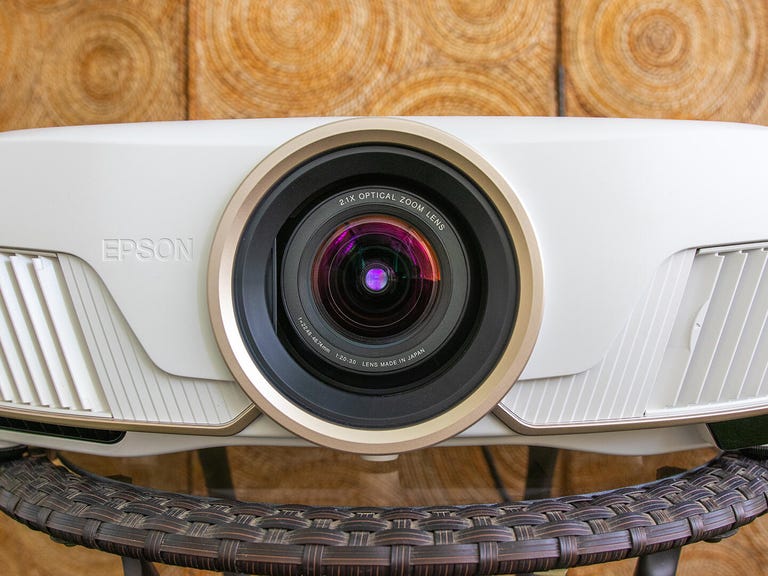
Best overall home theater projector
Epson Home Cinema 5050UB


- Bright, colorful, flexible
- Huge
The Epson Home Cinema 5050UB is the best all-around home projector we’ve reviewed. Take an excellent contrast ratio, paired with impressive brightness and accurate color, all with better detail than what’s possible with a 1080p native resolution projector, and you’ve got all the pieces for a fantastic image. This home entertainment projector isn’t cheap, but it offers a significant step up in image quality over other projectors on this list (aside from the Sony, which costs a lot more). It comes with HDMI 2.0, which lets you do 4K60p. Extensive lens shift and a motorized zoom are the icing on the cake.
Best 1080p projector
BenQ HT2060
The BenQ HT2060 replaces our longtime favorite, the HT2050A. It has many similarities, including 1080p resolution, lens shift and great color accuracy. The move to LEDs instead of a traditional lamp has two main benefits: First, the LEDs last the life of the projector, so no more replacing lamps; and second, it offers arich and lifelike image with impressive color accuracy. The downsides are a reduction in brightness overall, and the HT2060 is about 25% more expensive to purchase. However, because you don’t need to replace the lamps, the cost of ownership over the projector’s lifetime is far lower compared with the HT2050A.
- Excellent, lifelike color
- Decent contrast ratio
- Vertical lens shift
- Brightness is rather average
- A little pricey for 1080p
The BenQ HT2060 replaces our longtime favorite, the HT2050A. It has many similarities, including 1080p resolution, lens shift and great color accuracy. The move to LEDs instead of a traditional lamp has two main benefits: First, the LEDs last the life of the projector, so no more replacing lamps; and second, it offers arich and lifelike image with impressive color accuracy. The downsides are a reduction in brightness overall, and the HT2060 is about 25% more expensive to purchase. However, because you don’t need to replace the lamps, the cost of ownership over the projector’s lifetime is far lower compared with the HT2050A.
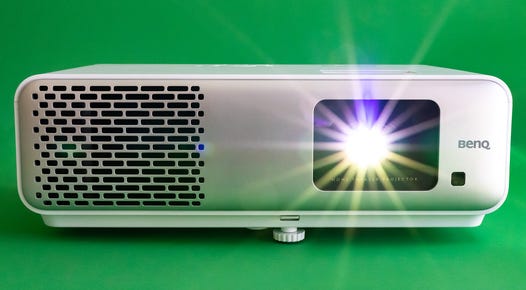
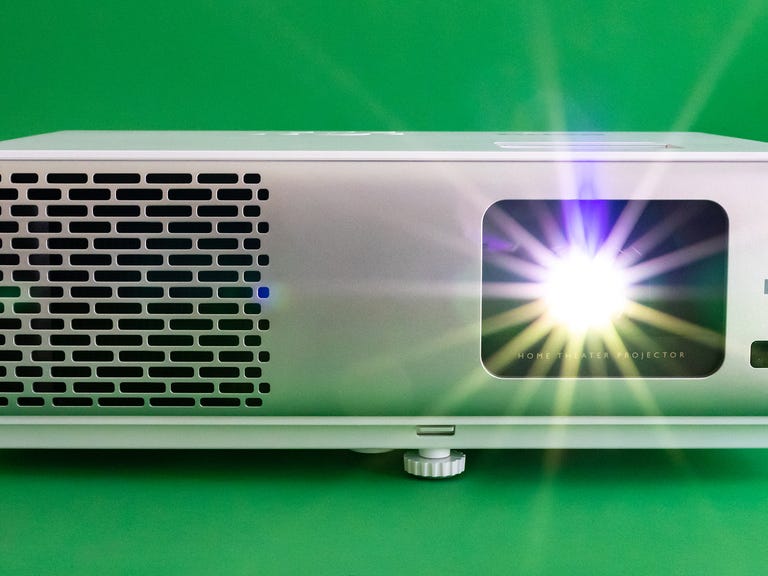
Head to head with its predecessor, the older projector still looks great, but overall the HT2060 is a little bit better. If your budget is around $1,000 and you have a light-controlled room, this is the projector to get. If you need some extreme light output, the Epson HC2350 mentioned below doesn’t look quite as good but is far brighter.
Best 1080p projector
BenQ HT2060


- Excellent, lifelike color
- Decent contrast ratio
- Vertical lens shift
- Brightness is rather average
- A little pricey for 1080p
The BenQ HT2060 replaces our longtime favorite, the HT2050A. It has many similarities, including 1080p resolution, lens shift and great color accuracy. The move to LEDs instead of a traditional lamp has two main benefits: First, the LEDs last the life of the projector, so no more replacing lamps; and second, it offers arich and lifelike image with impressive color accuracy. The downsides are a reduction in brightness overall, and the HT2060 is about 25% more expensive to purchase. However, because you don’t need to replace the lamps, the cost of ownership over the projector’s lifetime is far lower compared with the HT2050A.
Head to head with its predecessor, the older projector still looks great, but overall the HT2060 is a little bit better. If your budget is around $1,000 and you have a light-controlled room, this is the projector to get. If you need some extreme light output, the Epson HC2350 mentioned below doesn’t look quite as good but is far brighter.
Best budget 4K projector
Epson Home Cinema 2350
The Epson HC2350 is an extremely bright 4K projector at a great price. It has lens shift, built-in streaming and a compact size. Its price has fallen since it was released, so now it goes head-to-head with another favorite of ours, the 1080p BenQ HT2060 mentioned above.
- 4K
- Compact design
- Very bright
- Contrast is pretty mediocre
- Loud at max brightness
- Technically 4K but other projectors are sharper
The Epson HC2350 is an extremely bright 4K projector at a great price. It has lens shift, built-in streaming and a compact size. Its price has fallen since it was released, so now it goes head-to-head with another favorite of ours, the 1080p BenQ HT2060 mentioned above.

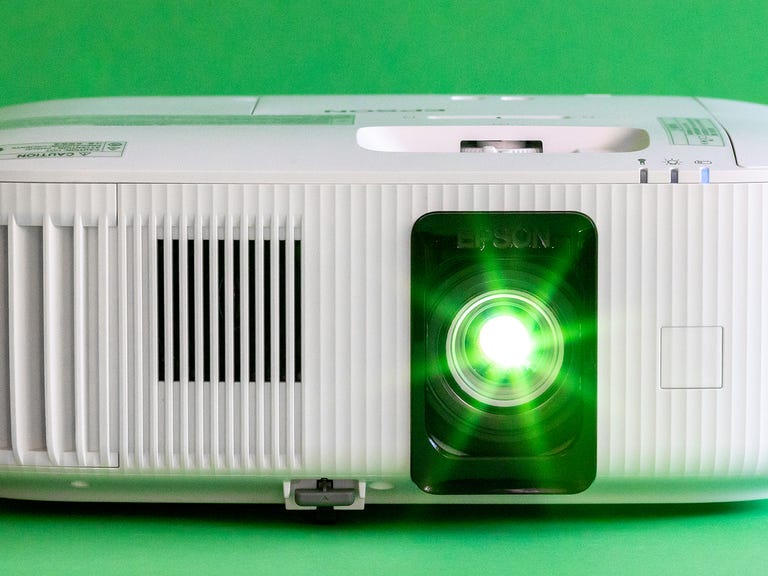
The HC2350 is impressively bright. It’s one of the brightest projectors we’ve ever measured. However, its contrast ratio isn’t great, well below average. As a result, its image is more washed out and “flat” compared with some other projectors, notably the aforementioned BenQ. While it’s 4K, the HC2350 uses LCDs to create its image, so it’s susceptible to motion blur. Because of that, it doesn’t always look as sharp as you might expect. If you’re ready for 4K and need something with extreme brightness, this is the best option anywhere near $1,000.
Best budget 4K projector
Epson Home Cinema 2350


- 4K
- Compact design
- Very bright
- Contrast is pretty mediocre
- Loud at max brightness
- Technically 4K but other projectors are sharper
The Epson HC2350 is an extremely bright 4K projector at a great price. It has lens shift, built-in streaming and a compact size. Its price has fallen since it was released, so now it goes head-to-head with another favorite of ours, the 1080p BenQ HT2060 mentioned above.
The HC2350 is impressively bright. It’s one of the brightest projectors we’ve ever measured. However, its contrast ratio isn’t great, well below average. As a result, its image is more washed out and “flat” compared with some other projectors, notably the aforementioned BenQ. While it’s 4K, the HC2350 uses LCDs to create its image, so it’s susceptible to motion blur. Because of that, it doesn’t always look as sharp as you might expect. If you’re ready for 4K and need something with extreme brightness, this is the best option anywhere near $1,000.
Best projector under $800
BenQ HT2050A
We wouldn’t put this in the “cheap projector” bucket, but the BenQ HT2050A is definitely the best video projector you can get for the money. It produces a bright picture with great contrast and lifelike color accuracy. It’s also one of the only comparable models with vertical lens shift, which makes setup a little easier. It supports most media players, gaming consoles, PCs, Macs and mobile devices with input options such as HDMI, USB and more. Plus, the projector offers a low input lag of 16ms for immersive gaming.
- Great picture quality for the price
- Limited lens shift and zoom
We wouldn’t put this in the “cheap projector” bucket, but the BenQ HT2050A is definitely the best video projector you can get for the money. It produces a bright picture with great contrast and lifelike color accuracy. It’s also one of the only comparable models with vertical lens shift, which makes setup a little easier. It supports most media players, gaming consoles, PCs, Macs and mobile devices with input options such as HDMI, USB and more. Plus, the projector offers a low input lag of 16ms for immersive gaming.

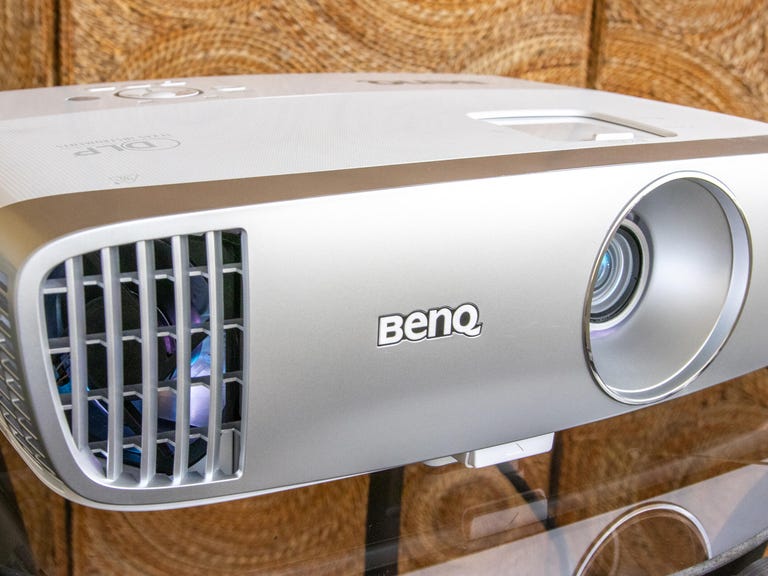
BenQ is discontinuing the HT2050A soon. Its replacement, the HT2060, is mentioned above. It’s a little more expensive, but it uses LEDs instead of the HT2050A’s replaceable lamps, so over its lifetime the HT2060 will be cheaper. If you don’t want to spend more to start, or want the HT2050A’s higher brightness, it’s a great deal while it’s still available.
Best projector under $800
BenQ HT2050A


- Great picture quality for the price
- Limited lens shift and zoom
We wouldn’t put this in the “cheap projector” bucket, but the BenQ HT2050A is definitely the best video projector you can get for the money. It produces a bright picture with great contrast and lifelike color accuracy. It’s also one of the only comparable models with vertical lens shift, which makes setup a little easier. It supports most media players, gaming consoles, PCs, Macs and mobile devices with input options such as HDMI, USB and more. Plus, the projector offers a low input lag of 16ms for immersive gaming.
BenQ is discontinuing the HT2050A soon. Its replacement, the HT2060, is mentioned above. It’s a little more expensive, but it uses LEDs instead of the HT2050A’s replaceable lamps, so over its lifetime the HT2060 will be cheaper. If you don’t want to spend more to start, or want the HT2050A’s higher brightness, it’s a great deal while it’s still available.
Best cheap projector
AAXA P8
The tiny P8 serves up a far bigger image than its size suggests. Though in fairness, the handheld size doesn’t suggest it could project an image at all — it looks more like a toy. But it’s reasonably bright, has a built-in speaker and costs only $250 or even less. Impressive.
- Tiny and bright
- Picture quality isn’t great
The tiny P8 serves up a far bigger image than its size suggests. Though in fairness, the handheld size doesn’t suggest it could project an image at all — it looks more like a toy. But it’s reasonably bright, has a built-in speaker and costs only $250 or even less. Impressive.

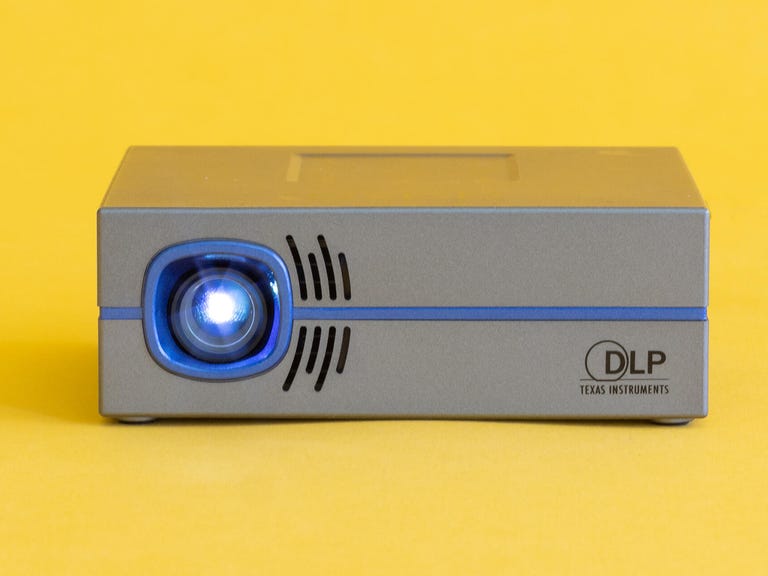
It doesn’t have a battery, nor does it have any streaming apps. So you’ll need to take that into consideration. It does have an HDMI input and a USB connection, so you can connect a streaming stick and get all the streaming apps you could possibly want. There are brighter options and better-looking options, but for the price the P8 is hard to beat. Read our AAXA P8 review.
Best cheap projector
AAXA P8


- Tiny and bright
- Picture quality isn’t great
The tiny P8 serves up a far bigger image than its size suggests. Though in fairness, the handheld size doesn’t suggest it could project an image at all — it looks more like a toy. But it’s reasonably bright, has a built-in speaker and costs only $250 or even less. Impressive.
It doesn’t have a battery, nor does it have any streaming apps. So you’ll need to take that into consideration. It does have an HDMI input and a USB connection, so you can connect a streaming stick and get all the streaming apps you could possibly want. There are brighter options and better-looking options, but for the price the P8 is hard to beat. Read our AAXA P8 review.
Best portable projector
Anker Nebula Mars II Pro
It’s smaller than a six-pack of Coke and equipped with Wi-Fi streaming, a surprisingly loud Bluetooth speaker and even a handle. It offers auto vertical and manual horizontal keystone correction. This portable mini projector powerhouse also has one thing many compact projectors like the Vimgo P10 lack: a built-in battery. This budget projector is an all-in-one entertainment machine that’s darn cute, too. It lists for around $550, but you can save $70 when you pick it up from Anker directly and use the promo code WSCPCC8CGG at checkout.
It’s smaller than a six-pack of Coke and equipped with Wi-Fi streaming, a surprisingly loud Bluetooth speaker and even a handle. It offers auto vertical and manual horizontal keystone correction. This portable mini projector powerhouse also has one thing many compact projectors like the Vimgo P10 lack: a built-in battery. This budget projector is an all-in-one entertainment machine that’s darn cute, too. It lists for around $550, but you can save $70 when you pick it up from Anker directly and use the promo code WSCPCC8CGG at checkout.


Best portable projector
Anker Nebula Mars II Pro


- Looks and sounds good for a portable
- Could be easier to use
It’s smaller than a six-pack of Coke and equipped with Wi-Fi streaming, a surprisingly loud Bluetooth speaker and even a handle. It offers auto vertical and manual horizontal keystone correction. This portable mini projector powerhouse also has one thing many compact projectors like the Vimgo P10 lack: a built-in battery. This budget projector is an all-in-one entertainment machine that’s darn cute, too. It lists for around $550, but you can save $70 when you pick it up from Anker directly and use the promo code WSCPCC8CGG at checkout.
Best projector, when money’s no object
Sony VPL-VE325ES
The Sony VPL-VW325ES is a thoroughbred among ponies, a Porsche among Volkswagens, an absolute stunner with a price tag to match. The contrast ratio, easily the most important aspect of overall picture quality, is better than that of the Epson 5050, and significantly better than that of any projector which doesn’t cost significantly more. And that’s saying something, since the Sony itself costs far more than any other projector on this list. It checks the box for gaming with the input lag reduction feature. And with brightness that can go up to 1,500 Lumens, it works well in a bright room as well. If price is no object, the picture quality is incredible.
The Sony VPL-VW325ES is a thoroughbred among ponies, a Porsche among Volkswagens, an absolute stunner with a price tag to match. The contrast ratio, easily the most important aspect of overall picture quality, is better than that of the Epson 5050, and significantly better than that of any projector which doesn’t cost significantly more. And that’s saying something, since the Sony itself costs far more than any other projector on this list. It checks the box for gaming with the input lag reduction feature. And with brightness that can go up to 1,500 Lumens, it works well in a bright room as well. If price is no object, the picture quality is incredible.

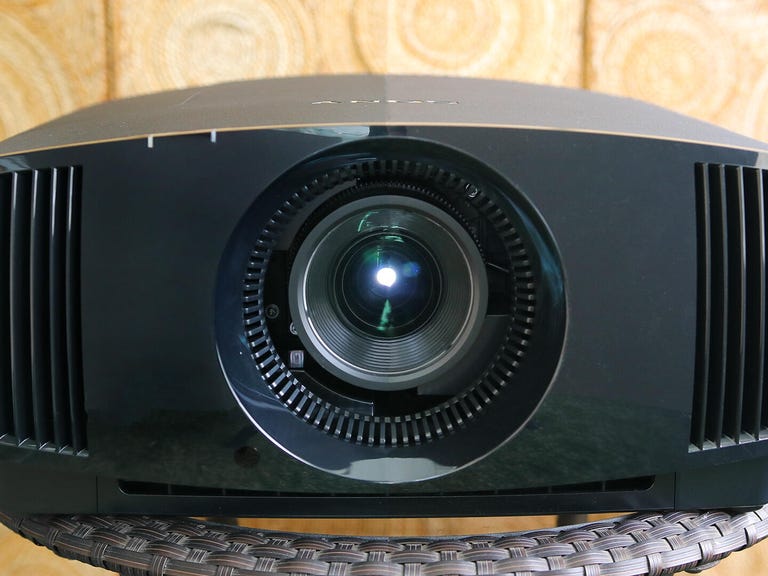
Sony has discontinued the VW325ES, but you can still find it available new online.
Best projector, when money’s no object
Sony VPL-VE325ES


- Incredibly fine image quality
- Incredibly high price
The Sony VPL-VW325ES is a thoroughbred among ponies, a Porsche among Volkswagens, an absolute stunner with a price tag to match. The contrast ratio, easily the most important aspect of overall picture quality, is better than that of the Epson 5050, and significantly better than that of any projector which doesn’t cost significantly more. And that’s saying something, since the Sony itself costs far more than any other projector on this list. It checks the box for gaming with the input lag reduction feature. And with brightness that can go up to 1,500 Lumens, it works well in a bright room as well. If price is no object, the picture quality is incredible.
Sony has discontinued the VW325ES, but you can still find it available new online.
Best 4K laser projector
Epson Home Cinema LS11000
The Epson Home Cinema LS11000 is similar to the Epson 5050, but instead of a lamp it uses a laser and phosphor combo to create light. This means even better color, no lamp replacements, faster turn on/off and a more usable dynamic contrast ratio. A more advanced different pixel shifter means better resolution than the 5050 as well. It’s more expensive to start, but over the life of the projector they should be about the same. So better picture quality for roughly the same total cost of ownership makes this well worth considering over the 5050. Read our Epson Home Cinema LS11000 review.
- Lasers!
- High initial price
The Epson Home Cinema LS11000 is similar to the Epson 5050, but instead of a lamp it uses a laser and phosphor combo to create light. This means even better color, no lamp replacements, faster turn on/off and a more usable dynamic contrast ratio. A more advanced different pixel shifter means better resolution than the 5050 as well. It’s more expensive to start, but over the life of the projector they should be about the same. So better picture quality for roughly the same total cost of ownership makes this well worth considering over the 5050. Read our Epson Home Cinema LS11000 review.

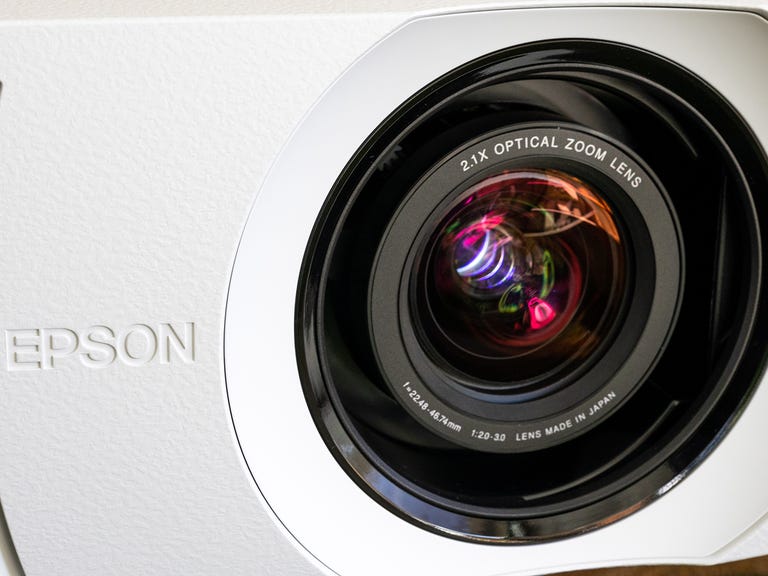
Best 4K laser projector
Epson Home Cinema LS11000


- Lasers!
- High initial price
The Epson Home Cinema LS11000 is similar to the Epson 5050, but instead of a lamp it uses a laser and phosphor combo to create light. This means even better color, no lamp replacements, faster turn on/off and a more usable dynamic contrast ratio. A more advanced different pixel shifter means better resolution than the 5050 as well. It’s more expensive to start, but over the life of the projector they should be about the same. So better picture quality for roughly the same total cost of ownership makes this well worth considering over the 5050. Read our Epson Home Cinema LS11000 review.
Best compact laser projector
Epson EF-12
The EF-12 is a small, highly portable projector that looks a lot like the Anker Nebula Pro and the BenQ GS50, but it fits a slightly different niche. It’s easy to tote and doubles as a Bluetooth speaker, but unlike those other two projectors, it can’t run on a battery — it requires AC power. The EF-12’s light is created by Epson’s “MicroLaser Array Projection Technology.” Yep, laser beams, which deliver a brighter picture than LED-based models like the Nebula and GS50.
The EF-12 is a small, highly portable projector that looks a lot like the Anker Nebula Pro and the BenQ GS50, but it fits a slightly different niche. It’s easy to tote and doubles as a Bluetooth speaker, but unlike those other two projectors, it can’t run on a battery — it requires AC power. The EF-12’s light is created by Epson’s “MicroLaser Array Projection Technology.” Yep, laser beams, which deliver a brighter picture than LED-based models like the Nebula and GS50.

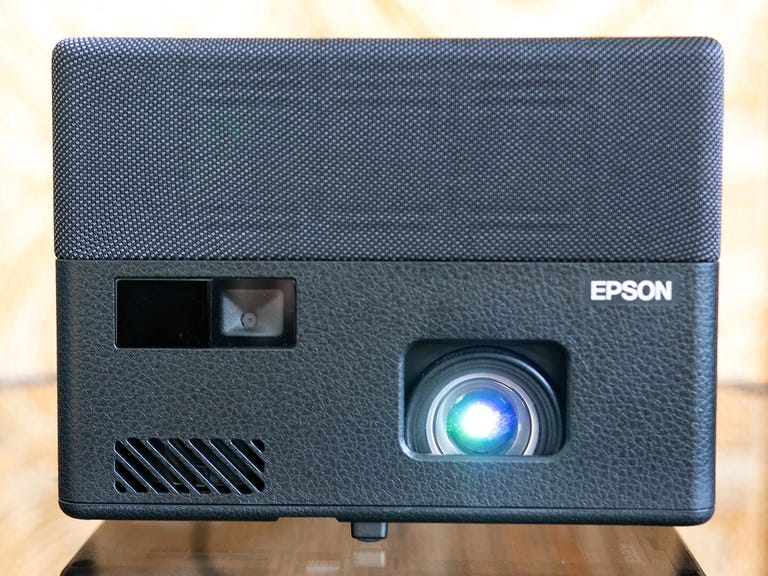
Best compact laser projector
Epson EF-12


- A shape any Borg would love
- Pricey for its performance
The EF-12 is a small, highly portable projector that looks a lot like the Anker Nebula Pro and the BenQ GS50, but it fits a slightly different niche. It’s easy to tote and doubles as a Bluetooth speaker, but unlike those other two projectors, it can’t run on a battery — it requires AC power. The EF-12’s light is created by Epson’s “MicroLaser Array Projection Technology.” Yep, laser beams, which deliver a brighter picture than LED-based models like the Nebula and GS50.
Best 4K laser projector runner-up
Optoma UHZ50
The Optoma UHZ50 uses a blue laser and a yellow phosphor to create some incredibly bright, ultracolorful images. It also has the second-best contrast ratio we’ve measured from a DLP projector. Also, because it’s DLP, it has excellent detail. The zoom range and lens shift are fairly limited, so it won’t fit in as many rooms as the Epson 5050 or LS11000, but otherwise it’s very good. Read our Optoma UHZ50 Projector review.
- Great detail, color and brightness
- Limited zoom and lens shift
The Optoma UHZ50 uses a blue laser and a yellow phosphor to create some incredibly bright, ultracolorful images. It also has the second-best contrast ratio we’ve measured from a DLP projector. Also, because it’s DLP, it has excellent detail. The zoom range and lens shift are fairly limited, so it won’t fit in as many rooms as the Epson 5050 or LS11000, but otherwise it’s very good. Read our Optoma UHZ50 Projector review.

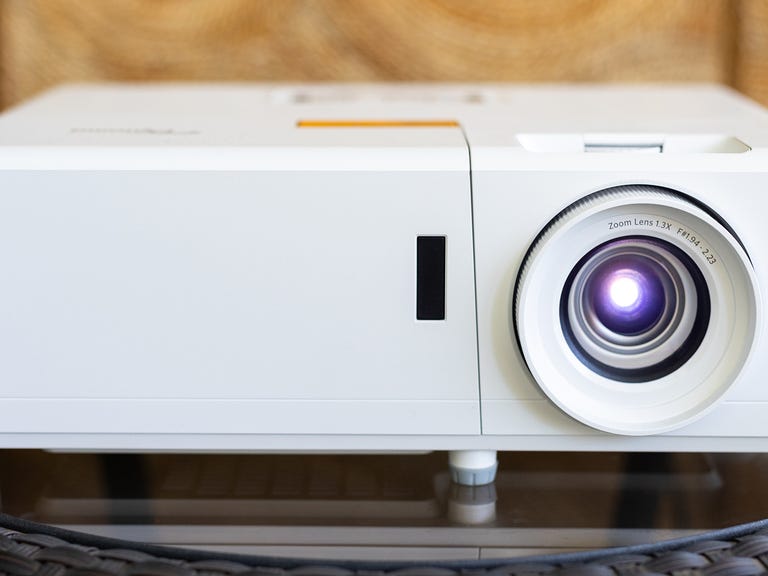
Best 4K laser projector runner-up
Optoma UHZ50


- Great detail, color and brightness
- Limited zoom and lens shift
The Optoma UHZ50 uses a blue laser and a yellow phosphor to create some incredibly bright, ultracolorful images. It also has the second-best contrast ratio we’ve measured from a DLP projector. Also, because it’s DLP, it has excellent detail. The zoom range and lens shift are fairly limited, so it won’t fit in as many rooms as the Epson 5050 or LS11000, but otherwise it’s very good. Read our Optoma UHZ50 Projector review.
Best 1080p portable projector
Xgimi Halo Plus
The Xgimi Halo Plus is a relatively small 1080p projector with a 2.5-hour battery and surprisingly powerful speakers. It has Android TV built in, so streaming is far easier than with many other portables. It performs well for a portable projector but costs about the same as the BenQ HT2050A, which does a much better job. But for regular movie nights far from an outlet, it works great. Also note that you can save $130 at Amazon right now by activating the instant coupon on the product page. Read our Xgimi Halo Plus review.
- Great performance for a portable
- Expensive
The Xgimi Halo Plus is a relatively small 1080p projector with a 2.5-hour battery and surprisingly powerful speakers. It has Android TV built in, so streaming is far easier than with many other portables. It performs well for a portable projector but costs about the same as the BenQ HT2050A, which does a much better job. But for regular movie nights far from an outlet, it works great. Also note that you can save $130 at Amazon right now by activating the instant coupon on the product page. Read our Xgimi Halo Plus review.
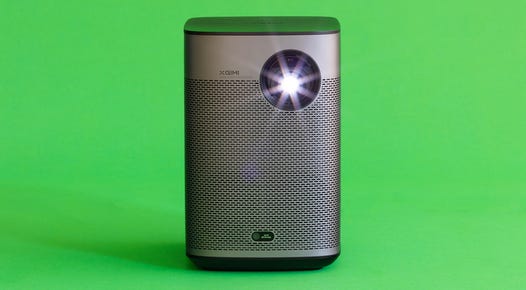
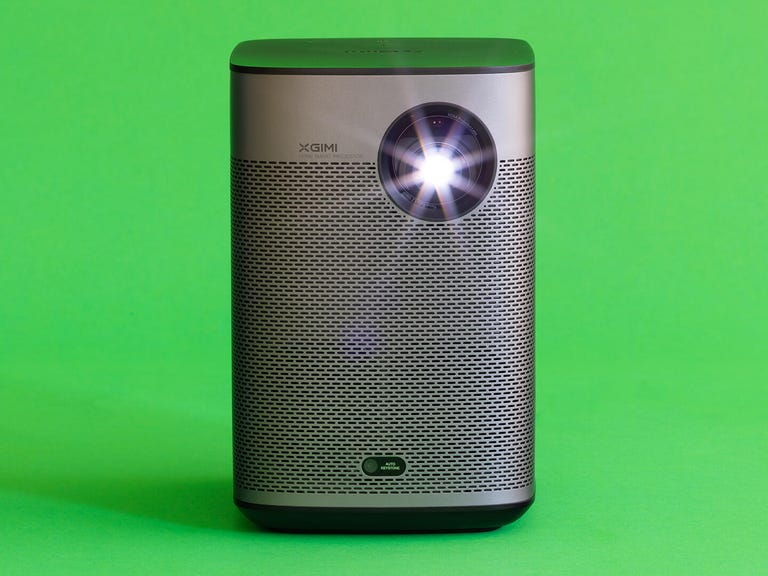
Best 1080p portable projector
Xgimi Halo Plus


- Great performance for a portable
- Expensive
The Xgimi Halo Plus is a relatively small 1080p projector with a 2.5-hour battery and surprisingly powerful speakers. It has Android TV built in, so streaming is far easier than with many other portables. It performs well for a portable projector but costs about the same as the BenQ HT2050A, which does a much better job. But for regular movie nights far from an outlet, it works great. Also note that you can save $130 at Amazon right now by activating the instant coupon on the product page. Read our Xgimi Halo Plus review.
Best cheap projector runner-up
Vimgo P10
The Vimgo P10’s price fluctuates between $140 and $270, in the same ballpark as our favorite cheap projector, the AAXA P8. It’s a lot larger than the P8. It’s the largest cheap projector we’ve tested, actually, making it far less portable. But it’s still “small” compared with full-size and more expensive projectors, however.
- Incredibly cheap
- Watchable but not great image
The Vimgo P10’s price fluctuates between $140 and $270, in the same ballpark as our favorite cheap projector, the AAXA P8. It’s a lot larger than the P8. It’s the largest cheap projector we’ve tested, actually, making it far less portable. But it’s still “small” compared with full-size and more expensive projectors, however.

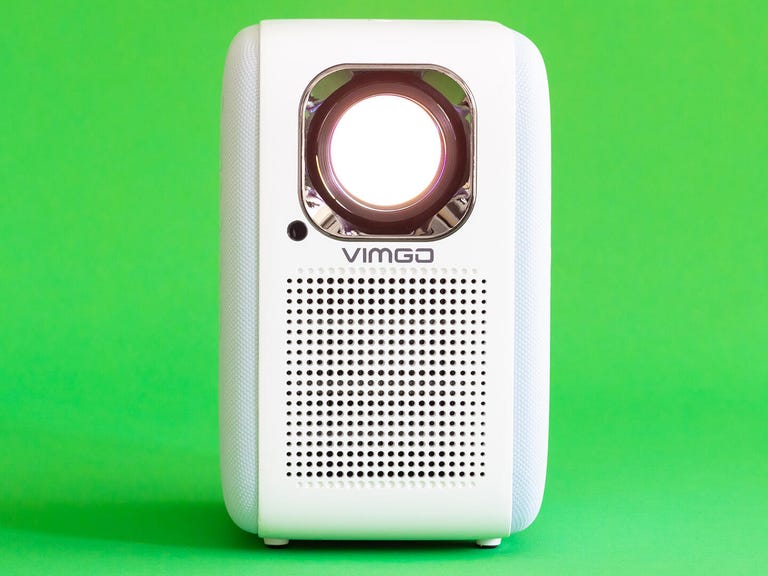
Picture quality is better than that of the P8 in some ways, worse in others. The Vimgo P10 has a great contrast ratio and decent brightness, but the color is remarkably terrible. The center of the image is noticeably sharper and brighter than the rest of the image. It’s not great.
But the price is. A perfectly watchable image for less than $150. It even has Netflix built in. Impressive. Read our Vimgo P10 review.
Best cheap projector runner-up
Vimgo P10


- Incredibly cheap
- Watchable but not great image
The Vimgo P10’s price fluctuates between $140 and $270, in the same ballpark as our favorite cheap projector, the AAXA P8. It’s a lot larger than the P8. It’s the largest cheap projector we’ve tested, actually, making it far less portable. But it’s still “small” compared with full-size and more expensive projectors, however.
Picture quality is better than that of the P8 in some ways, worse in others. The Vimgo P10 has a great contrast ratio and decent brightness, but the color is remarkably terrible. The center of the image is noticeably sharper and brighter than the rest of the image. It’s not great.
But the price is. A perfectly watchable image for less than $150. It even has Netflix built in. Impressive. Read our Vimgo P10 review.
Factors to consider
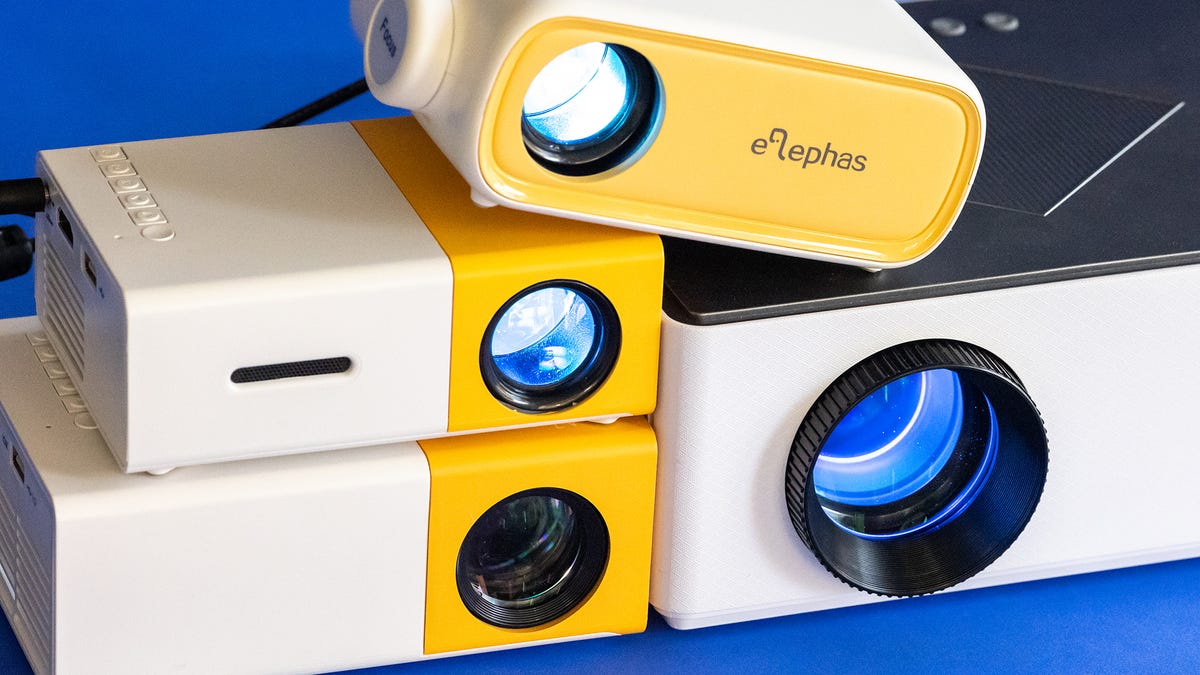
Picture quality: Projectors lag behind TVs when it comes to overall picture quality. However, they largely make up for it with absolutely massive images. Want a TV that’s 100-inches or more? Only a projector can do that, if you’re not ultrarich. Even so, there’s a wide range of picture quality even among projectors of a similar price. A projector with a great contrast ratio but only average light output is going to look better than the opposite. However, a brighter projector will be easier to see with some lights on, and can create an even bigger image.
Where are you using it?: For light controlled rooms and home theaters, a projector with a high contrast ratio is better than one that prioritizes light output. For mixed-use rooms where it’ll be hard or impossible to totally control the ambient light, or if you want an outdoor movie night with an image the size of the side of your house, one that prioritizes light output will be better, because the contrast ratio won’t be as noticeable.
What about X spec?: Ignore the specs. Companies claim million-to-one contrast ratios, insane brightness ratings, and even more. But the specs are largely divorced from reality. A claimed 2,000 lumen projector is probably brighter than a 500 lumen projector, but 1,500 and 1,700 lumen projectors are probably the same.
How much should you spend?: $1,000 is the sweet spot with projectors, where you can get great picture quality and brightness. Less than that usually requires a compromise of some kind. Some highly portable and battery-powered models are far less. They’re not as bright, but they’re great for their intended use. Spending more gets you incremental improvements. Above $3,000 there’s a big jump in picture quality again, and from there the sky’s the limit. Great picture quality, but they’re well beyond what we usually test.
What features should you look for?: If you’re connecting the projector to an audio system (and you should, either receiver/speakers or soundbar), then you don’t really need many features in the projector itself. Just get one that has great picture quality and high brightness. Lens shift and zoom are handy if you want more flexibility in placement. If you’re looking for some kind of “all-in-one” device with speakers, make sure it has a full version of Android TV inside for streaming, otherwise you’ll want to connect a streaming stick like Roku. This is because many highly portable and budget models use the Aptoide store, which won’t have as many streaming app options, and those it does have often have compromised functionality (no HD, difficult to navigate, and so on).
How we test home theater projectors
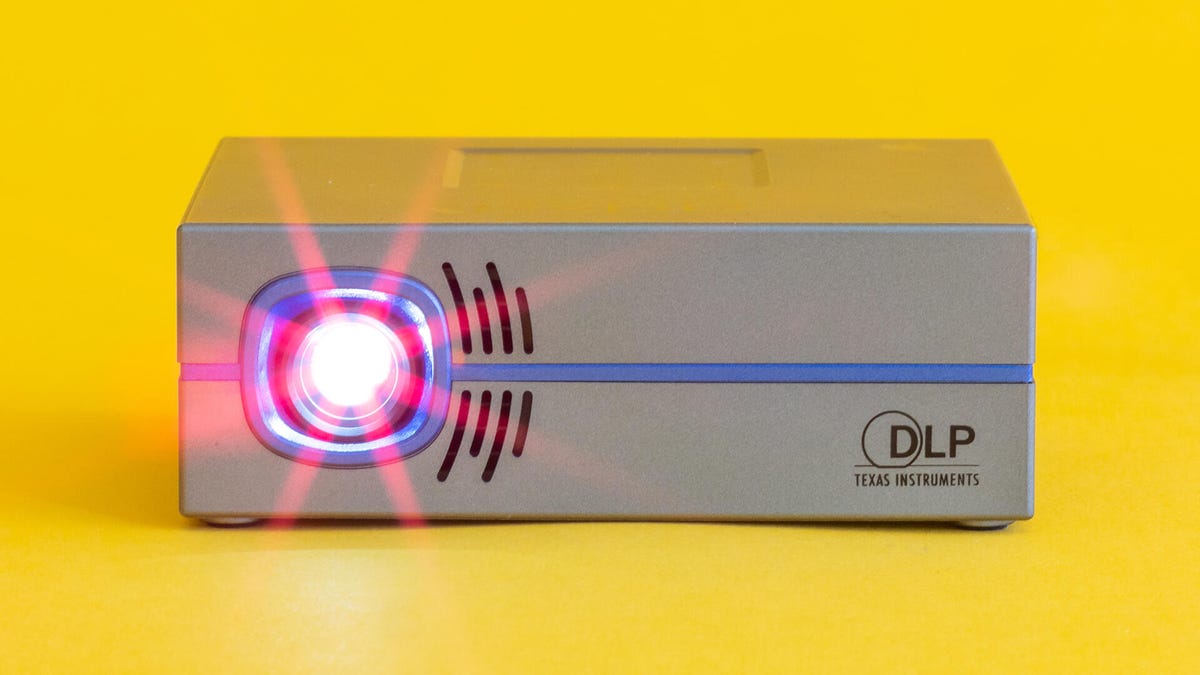
CNET puts projectors through a rigorous and unbiased testing process that’s the culmination of more than two decades of projector reviews. We use specialized test equipment, including a Photo Research spectroradiometer, a Minolta LS-100 luminance meter and an AEMC CA813 illuminance meter. The data is collected and collated by Portrait Displays CalMan Ultimate software, which helps us evaluate every PJ we review. Every lamp-based projector is “burned in” for 50 hours before measuring, and all projectors are initially set up using their most accurate color temp and color modes. Test patterns, sent from CalMan, are then used to adjust the various picture settings so the projector looks its best before measurement and evaluation. Contrast ratios are measured in each lamp and iris mode (when available). Once the projectors are fully set up and objectively measured, we watch a variety of content, including TV, movies, and games, both with the projector by itself, and compared side-by-side with two direct competitors.
Broadly speaking, we’re looking for the three picture quality aspects: contrast ratio, overall light output and color reproduction. Contrast ratio is the most important part of any projector’s performance. It’s the difference between the darkest part of the image and the brightest. While certain TV technologies, like OLED, can create a black that’s the actual absence of light, no projector technology can do this. Because of this, contrast ratios with projectors are far lower. It’s the difference between a washed out and “flat” image and one that’s more lifelike and “pops.” The better projectors will have a measured contrast ratio in the thousands. Most are between 500-1000:1.
Light output is the second most important factor, because it’s not only how bright the image appears on your wall, but also how big an image you can produce. Most modern projectors are significantly brighter than projectors from even 10 years ago. We measure brightness in candelas per square meter (cd/m2) and then convert to estimated lumens for ease of comparison. It’s important to note that we use the most accurate color temperature mode for our brightness comparisons, but we’ll note when a less-accurate mode is significantly brighter. Most of the projectors we test are between 1,000-2,000 lumens, with battery-powered models far less, and some specialized projectors even higher.
Color accuracy is the last major factor. No projector can truly take advantage of HDR or wide color gamut, but some can do more than others. Generally, we’re satisfied with accurate colors, but adding HDR effects is a bonus. Most home theater projectors we test are fairly accurate. Budget models, those that prioritize brightness over everything, and PJs from newcomers to the projector space, often have wildly inaccurate colors that result in a very unnatural image.
Other factors, like video processing and HDR processing, are evaluated in the viewing tests. These are rarely a major factor in projector performance, but some models still use older chips that have issues.
The best projector will have a high contrast ratio, high brightness and great color. Those are difficult to do at the same time, but as long as the balance works and it looks better than its competitors at a similar price, it’s a winner.
For more info, check out how CNET tests projectors.
Projector performance comparison
| Brand | Model | Price | Resolution | Lumens** | Contrast ratio** |
|---|---|---|---|---|---|
| Anker | Mars II Pro | $547 | 720p | 337 | 354:1 |
| Anker | Nebula Solar | $500 | 1080p | 196 | 407:1 |
| BenQ | HT2060 | $999 | 1080p | 985 | 1,380:1 |
| BenQ | HT2050A | $749 | 1080p | 1,591 | 2,094:1 |
| BenQ | TH685 | $1,244 | 1080p | 1,641 | 853:1 |
| Epson | EF-12 | $700 | 1080p | 650 | 394:1 |
| Epson | HC 880 | $738 | 1080p | 2,085 | 221:1 |
| Epson | HC 2250 | $750 | 1080p | 1,729 | 1,026:1 |
| Epson | HC 5050 | $2,500 | 1080p x2* | 1,732 | 5,203:1 |
| Epson | LS11000 | $3,500 | 4K | 1,378 | 1,808:1 |
| LG | HU810PW | $2,000 | 4K | 1,498 | 490:1 |
| Optoma | UHD35 | $1,581 | 4K | 1,567 | 649:1 |
| Optoma | UHZ50 | $2,799 | 4K | 1,486 | 1,007:1 |
| Sony | VPL-VE325ES | $5,398 | 4K | 1,732 | 5,203:1 |
| Xgimi | Halo Plus | $849 | 1080p | 284 | 368:1 |
*See review for more details
**As measured. See how CNET tests projectors for details.
Other projectors we’ve tested
BenQ GS50: The GS50 is a lunch box-size 1080p projector with a built-in battery. You can even use it as a Bluetooth speaker. However, it’s dimmer than the Xgimi Halo Plus for similar money, so we recommend that one instead.
Samsung Freestyle: The small, cylindrical Freestyle is an interesting idea, but it comes up short. It’s about the size of a Bluetooth speaker and in fact can double as one, and the Freestyle can pivot on its stand to project an image at any height on walls and even the ceiling. Its built-in streaming is far better implemented than with most portable projectors. However, it lacks a battery and its performance is average, at best. Worse, its price is a good 50% higher than it should be based on how it looks and performs. Read our Samsung Freestyle review.
Xiaomi Mi Smart Projector 2: Another relatively expensive projector we didn’t love, the Xiaomi at least has a gorgeous, Apple-like design going for it. We appreciated the compact size, 1080p resolution and built-in Android TV streaming, but the cons outweigh the pros. It’s relatively dim, especially for the price, and it lacks both a built-in battery and compatibility with a USB power source, so it’s not truly portable. Read our Xiaomi Mi Smart Projector 2 review.
Epson Home Cinema 880: The 880 is one of Epson’s less expensive home projectors, but it still puts out a remarkable amount of light. That and the price make it tempting. The contrast ratio is terrible, however, so the overall image quality is weak. Read our Epson Home Cinema 880 review.
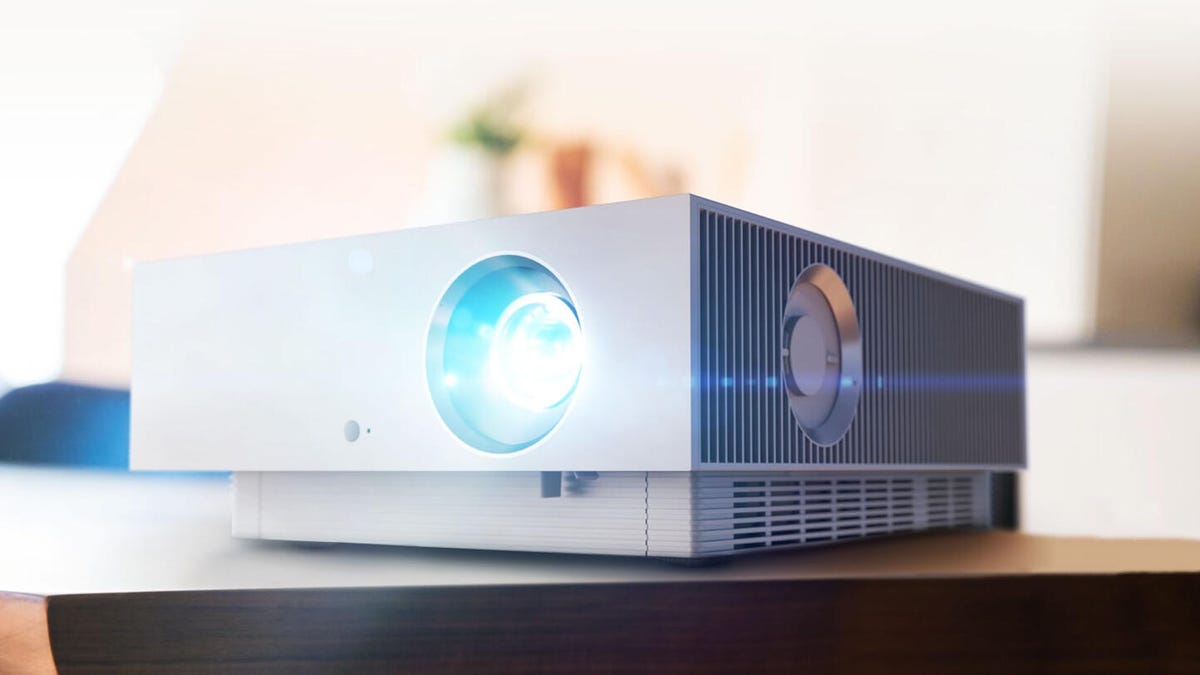
LG HU810PW: The HU810PW is a higher-end, laser-powered projector with 4K resolution that’s able to create some lovely, colorful images. It’s also quiet and sports an attractive, boxy case. The contrast ratio is quite poor, so it doesn’t look nearly as good overall as other projectors in its price range. Read our LG HU810PW review.
Anker Nebula Solar Portable: The Solar Portable is a portable projector with a built-in battery that lasts three hours. It sports 1080p resolution, but it’s not very bright and the contrast isn’t great. Though the Anker Mars II Pro has its own issues, overall it’s the better option for the same money. Read our Anker Nebula Solar Portable review.
Anker Nebula Cosmos Laser 4K: Since it has a handle and it’s a compact size, the Cosmos Laser 4K is technically portable, but it’s hardly mini at more than 10 pounds. There’s also no battery, so you’ll need to plug it in. It’s nice and bright, but the other downsides — lack of zoom, average overall image quality and a steep price for what you get — keep it off this list. Read our Anker Nebula Cosmos Laser 4K Projector review.
What is the best mini projector?
Mini projectors are projectors small enough to hold easily in one hand. They’re incredibly portable, but they’re not as bright as their larger counterparts, nor do they look as good. Overall, we like the AAXA P8 for its small size and high performance for its category.
Mini projectors are projectors small enough to hold easily in one hand. They’re incredibly portable, but they’re not as bright as their larger counterparts, nor do they look as good. Overall, we like the AAXA P8 for its small size and high performance for its category.
For more options, check out our list of the best portable mini projectors.
What is the best mini projector?
Mini projectors are projectors small enough to hold easily in one hand. They’re incredibly portable, but they’re not as bright as their larger counterparts, nor do they look as good. Overall, we like the AAXA P8 for its small size and high performance for its category.
For more options, check out our list of the best portable mini projectors.
What is the best projector for outdoor movies?
If you want to move movie night outdoors, you have a few options. We generally recommend, when possible, to use a regular home projector and run an extension cord. Home projectors will offer far better, brighter images, for the same or less money than portable projectors.
If you want to move movie night outdoors, you have a few options. We generally recommend, when possible, to use a regular home projector and run an extension cord. Home projectors will offer far better, brighter images, for the same or less money than portable projectors.
If you want to go fully cordless, we like the Xgimi Halo Plus. It’s fairly expensive, but it offers decent battery life and image quality.
For more options, check out our list of the best outdoor projectors.
What is the best projector for outdoor movies?
If you want to move movie night outdoors, you have a few options. We generally recommend, when possible, to use a regular home projector and run an extension cord. Home projectors will offer far better, brighter images, for the same or less money than portable projectors.
If you want to go fully cordless, we like the Xgimi Halo Plus. It’s fairly expensive, but it offers decent battery life and image quality.
For more options, check out our list of the best outdoor projectors.
What kind of projector should you get?
LCD and Digital Light Processing projectors are the most common technologies. Higher-end projectors often use LCOS, or liquid crystal on silicon, designs. These are marketed as SXRD and DILA. LCOS is superior to LCD and DLP in almost every way, but it’s significantly more expensive.
LCD and Digital Light Processing projectors are the most common technologies. Higher-end projectors often use LCOS, or liquid crystal on silicon, designs. These are marketed as SXRD and DILA. LCOS is superior to LCD and DLP in almost every way, but it’s significantly more expensive.
LCD (used almost exclusively by Epson) and DLP both have their strengths and weaknesses. DLP is typically sharper, LCD often brighter. However, both technologies offer bright, sharp images. It’s more down to the specific model of projector than specific technologies.
What kind of projector should you get?
LCD and Digital Light Processing projectors are the most common technologies. Higher-end projectors often use LCOS, or liquid crystal on silicon, designs. These are marketed as SXRD and DILA. LCOS is superior to LCD and DLP in almost every way, but it’s significantly more expensive.
LCD (used almost exclusively by Epson) and DLP both have their strengths and weaknesses. DLP is typically sharper, LCD often brighter. However, both technologies offer bright, sharp images. It’s more down to the specific model of projector than specific technologies.
Do you need a screen for a better projector experience?
You can use any flat surface to project your image. However, don’t expect it to be the best surface for a projector. Any and all tiny bumps in a wall, for example, will be visible as extra “noise” in the image. This can be distracting. If you want the best image quality from your projector, even an inexpensive screen is a far better option. This is because projector screens tend to brighten the image noticeably and create a smooth surface that best shows off your TV program, movie or game.
You can use any flat surface to project your image. However, don’t expect it to be the best surface for a projector. Any and all tiny bumps in a wall, for example, will be visible as extra “noise” in the image. This can be distracting. If you want the best image quality from your projector, even an inexpensive screen is a far better option. This is because projector screens tend to brighten the image noticeably and create a smooth surface that best shows off your TV program, movie or game.
Do you need a screen for a better projector experience?
You can use any flat surface to project your image. However, don’t expect it to be the best surface for a projector. Any and all tiny bumps in a wall, for example, will be visible as extra “noise” in the image. This can be distracting. If you want the best image quality from your projector, even an inexpensive screen is a far better option. This is because projector screens tend to brighten the image noticeably and create a smooth surface that best shows off your TV program, movie or game.
Should I buy a portable or home projector?
Portable models are expensive for their performance, but they can work where there’s no outlet. If you don’t plan on ever using the projector away from your house, a traditional projector will be far brighter and can be used outside. Just remember to bring it in when you’re done.
Portable models are expensive for their performance, but they can work where there’s no outlet. If you don’t plan on ever using the projector away from your house, a traditional projector will be far brighter and can be used outside. Just remember to bring it in when you’re done.
Should I buy a portable or home projector?
Portable models are expensive for their performance, but they can work where there’s no outlet. If you don’t plan on ever using the projector away from your house, a traditional projector will be far brighter and can be used outside. Just remember to bring it in when you’re done.


